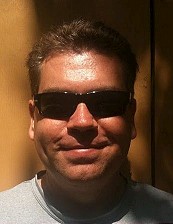Since the beginning of the year I have lost over 20 lbs. I have also been working out and building muscle, so I have probably lost more than 20 lbs in fat.
I feel that for the first time in my life I have a good handle on my weight. Below, I have some thoughts on what has changed for me – if you struggle with your weight you may find a tip or two useful.
How I lost 20 lbs - Thoughts and Tips
For most of my adult life I feel I have struggled with my weight. I can’t say I was extremely fat, but I always felt I was not in control – that the more I grew older the fatter I was getting.

Me, before and after (not really, but I thought this would be funny).
I’m a Software Engineer and I believe science gets us closer to the truth – so having a better understanding of why I gain or lose weight was the key for me.
It really breaks down to understanding these two numbers:
- Calories Burned: the number of calories your body burns in any given day. This really depends on your metabolism – for example my body will burn between 2,000 to 2,500 calories per day even if I just stay in bed the whole time. The more physically active you are, the more calories you burn – I found I can burn 300 to 400 calories in a typical workout.
- Calories Eaten: the number of calories you eat in any given day. This number can vary depending on what you eat and how much you eat. Go to McDonald’s and eat hamburgers, fries, and milk-shakes and you could easily be eating 3,000 to 4,000 calories in one meal. Eat a salad with low fat dressing and you’re eating 300 to 350 calories.
Once I understood the above, for me it’s now a question of math:
| Gain Weight – Get Fat | Lose Weight – Get Healthy | |
| Calories Burned < Calories Eaten | Calories Burned > Calories Eaten | |
| Example: You don’t exercise, so you burn your standard 2,000 calories per day. You eat lunch at McDonald’s (1,800 calories) and dinner at TGI Friday’s (2,800 calories). You ate 4,600 calories and burned 2,000 that day – you gained fat. | Example: You don’t exercise, so you burn your standard 2,000 calories per day. You eat a small breakfast, a couple of eggs and a tomato (300 calories), a Lean Cuisine lunch (380 calories), an afternoon snack (100 calories), a dinner (500 calories) and even a desert (400 calories). You ate 1,700 calories and burned 2,000 that day – you lost fat. |
Most folks know the above to be true – the question is how do you keep track of the above numbers. Below I have some thoughts on what has worked for me.
Disclaimer: the tips and ideas below work for me – I’m posting them here so they can help others. Some of these tips might work for you, some might not – you need to find what works for you for eating less calories without being hungry. The end goal is to lose weight – find what works for you.
Yes, I’m simplifying – but it all starts with this simple math; if you disagree, have a good life, but I don’t care about miracle solutions and please don’t send me any hate mail.
Tips and ideas:
- You need to know how many calories you burn per day. If you don’t, how can you know if you are losing or gaining fat?
- You need to know how many calories you eat per day. If you don’t, how can you know if you are losing or gaining fat?
- This is a great tool: FitBit Tracker, http://www.fitbit.com/ ($99, no monthly fees) – it tracks how many calories you burn and more. The Fitbit Tracker contains a motion sensor like the ones found in the Nintendo Wii. The Tracker senses your motion in three dimensions and converts this into useful information about your daily activities. The Tracker measures the intensity and duration of your physical activities, calories burned, steps taken, distance traveled, how long it took you to fall asleep, the number of times you woke up throughout the night and how long you were actually asleep vs just lying in bed. You can wear the Tracker loosely in your pocket or clipped to your clothing. There’s also a great website where you can manually enter food you’ve eaten to track how many calories you’ve eaten. Even if you don’t exercise, the FitBit Tracker helps you by giving you a scientific idea on how many calories you burn per day.
- Here’s another great tool: Withings, a WiFi scale linked to the internet that automatically register weight, fat and BMI calculation. http://www.withings.com/ ($159). This is optional – it just makes it really easy to track your progress, but a standard scale also works.
- Get a personal trainer – I never knew how to work out – I needed to learn. If you are in the San Jose area, I highly recommend Vivek – check out his site at http://bodycompgym.com/. If financially this is not an option for you, workout on your own 2 to 3 times per week.
- You don’t need to workout to lose fat. Working out is good for you for many reasons, but on any given day you can lose fat without working out at all.
- When working out, don’t just do cardio. You need to build muscle – the more muscle you have the more calories your body will burn per day (not related to workouts or physical activity – just the number of calories your body will burn even if you’re just in bed the whole day).
- Watch the movie “Food Inc.” – it’s an eye opener. http://www.foodincmovie.com/ and http://www.imdb.com/title/tt1286537/
- Ignore people that tell you that losing weight is not as simple as counting calories in and out. It’s true that our metabolism is way more complicated and there are other factors – but it all starts with calories in and calories out. You can’t convince me that if you eat more calories than what you burn that you can lose weight – it’s science, not faith.
- Find your ideal weight range, you want to be in that range. Here’s a sample online calculator: http://www.halls.md/ideal-weight/body.htm
- Don’t think about “dieting” – think about changing your lifestyle for the long run – where you are aware that you should be consuming less calories than what you burn (if you want to lose weight).
- In the US, 24 Hour Fitness has a tool like the FitBit, the “Body Bugg” - http://www.bodybugg.com/; I had one at some point – it was more expensive ($250) and the web site is not as good as fitbit.com.
- Being fat will cause me to die younger – Janelle has correctly pointed out: “How may very old fat folks do you know?”.
- Being extremely overweight or obese, will probably cause me to get sick before I die, for example I will probably have diabetes.
- When going to the restaurant, ask for a menu that contains the calorie count for each dish. In California there is a law effective since 7/1/2009 that require restaurant chains with at least 20 restaurants to disclose how many calories are in their standard menu items. For example, if you go to TGI Friday’s you’ll probably be eating 3,000 to 4,000 calories per meal – their salads are almost 1,000 calories!
- Watch the movie “Super Size Me” - http://www.imdb.com/title/tt0390521/
- It’s more important to keep an eye on what I eat than to work out. In other words, if I eat junk food, my workouts won’t matter much – we are talking thousands of calories eaten, while only a few hundred are burned with much effort. For me it’s 80% food, 20% workout.
- McDonald’s slogan should be: “Eat this cheap shit and die”. If you are a teenager with a metabolism that makes your body burn thousands of calories per day, it may not matter. But when you eat a Big Mac w/ fries and a milk-shake twice (roughly 2,000 calories) and you only burn 1,500 calories per day – you are going to get fat.
- Eat less (smaller portions) – for example Janelle and I will now often split one entree at the restaurant. The portions in San Francisco Bay Area restaurants are huge!
- Read the book “Food Rules: An Eater's Manual” http://www.amazon.com/Food-Rules-Eaters-Michael-Pollan/dp/014311638X/ (Kindle edition here).
- It’s ok to eat one or two high calorie meals one day a week – otherwise you go nuts.
- If someone criticizes what you eat, politely tell them they’re right but they don’t know your overall effort for the week, or the details in your life. You eat dozens of times during the month and it’s ok to have a treat at the restaurant every once in a while.
- For me it was critical to find low calorie foods I can eat that fill me up – where I’m not constantly hungry.
- Gastric bypass surgery is not a good answer, except for extreme cases. The long-term mortality rate of gastric bypass patients has been shown to be reduced by up to 40% – see this http://en.wikipedia.org/wiki/Gastric_bypass_surgery. Before considering such extreme procedures, try to just use the tips here and lose weight naturally.
- The hardest thing was to break away from the habits I had of eating high-caloric foods – something I still struggle with on a daily basis.
- Don’t get discouraged: you may have a bad day or even a bad week. But don’t give up, you still have many days and weeks left in your life. In previous “diets”, at some point I’d get discouraged and ended up eating peanut butter. I’d then “stop the diet”, eat junk food and other high-caloric junk, and would end up re-gaining all the weight back. It’s not about dieting, it’s about eating what is good for you and your body – for life.
- If you can’t find a good diet and you’re ok financially, consider hiring a nutritionist.
- What foods work for you? Send me an email or leave a comment below.
- Good foods I like:
- Lean Cuisines microwave ready meals - roughly 300 calories per meal.
- Chicken Breast
- Avocados (high calories, but good fat)
- Tuna
- Eggs
- Chewing Gum
- Almonds
- Coke Zero
- Yogurts (100 calories per serving max).
- Vegetables: tomatoes, lettuce, cabbage, onions, cucumbers/pickles, hearts of palm, carrots, cauliflower, broccoli.
- Fruits: Bananas, strawberries, cherries, nectarines, oranges.
- Low fat dressing (60 calories for 2 tbsp) – watch the dressing when eating out: a fast food salad can come with a dressing that is just as bad as a hamburger + fries.
- Bad foods I like, that I struggle to stay away from:
- Chocolate (Dove now has a bar with 180 calories)
- Hamburgers
- Fries / Potatoes
- Pasta
- Pizza
- Rice
- Chips, peanuts, etc…
- Ice-Cream
- Bread
- Cake/Cookies
- Peanut Butter
- Popcorn
- Large sandwiches – eat a 6 inch Subway sandwich instead of a footlong and, for example, you’ll be consuming 400 calories instead of 800.
- Large meals at good restaurants.
- Note: I don’t completely stay away from the foods above – every once in a while I do eat them, otherwise I’d go nuts. But I try to eat these in smaller quantities and not often.
Some of the above thoughts and tips are edited as I remember more details or find something new.



Comments